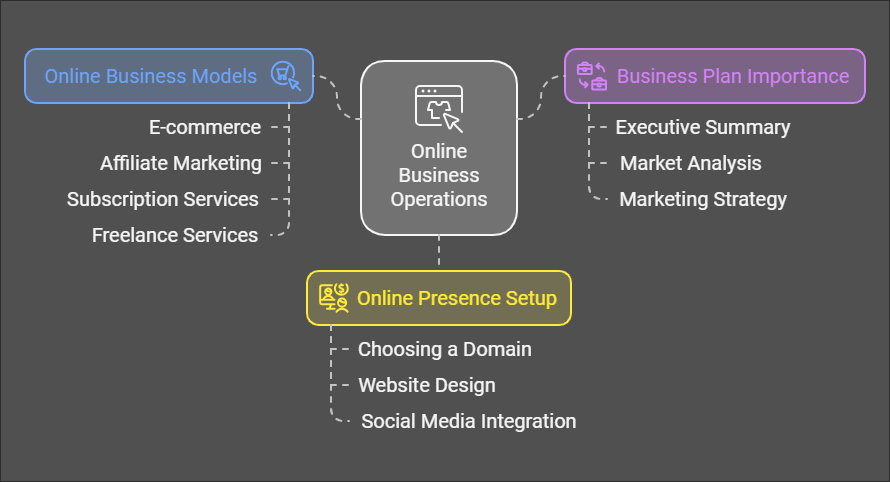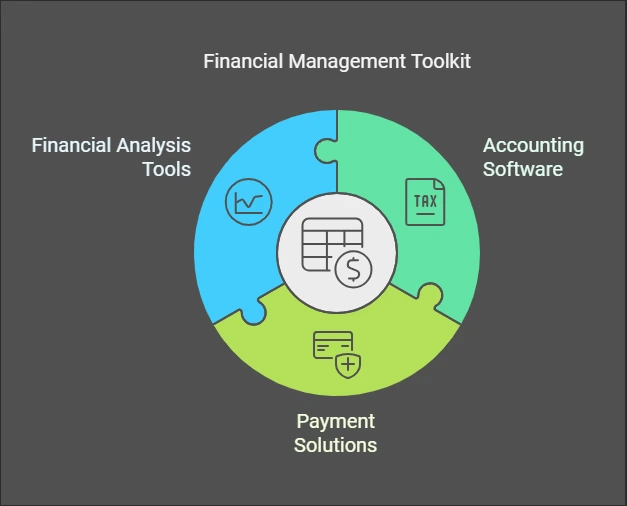Table of Contents
1. Understanding the Basics of Online Business Operations

1.1 Defining Online Business Models
Running an online business can take many forms. Here’s a quick overview of some common online business models:
- E-commerce: Selling products directly to consumers through your website.
- Affiliate Marketing: Promoting other companies’ products and earning a commission on sales.
- Subscription Services: Offering products or services for a recurring fee.
- Freelance Services: Providing professional services independently.
Each model has its pros and cons. For example, e-commerce can bring in substantial sales, but it requires inventory management. Choosing the right model depends on your goals, resources, and market demands.
1.2 Importance of a Business Plan
A solid business plan is like a roadmap for your online venture. Here are key components to consider:
- Executive Summary: A brief overview of your business idea.
- Market Analysis: Understanding your target audience and competitors.
- Marketing Strategy: How you plan to attract and retain customers.
To create an actionable plan, start by outlining your goals and specific steps to achieve them. Be ready to adapt as market trends change; flexibility is crucial!
1.3 Setting Up an Online Presence
Your online presence starts with a great domain name and hosting solution. Here’s how to get started:
- Choosing a Domain: Pick a memorable name that reflects your brand.
- Website Design: Keep it user-friendly. Think about layout, colors, and graphics that resonate with your audience.
- Social Media Integration: Make sure your website links to your social media accounts for a cohesive online identity.
2. Essential Tools for Productivity and Management
2.1 Project Management Software
Managing tasks and projects efficiently is vital. Popular tools like Trello, Asana, and Monday.com can help streamline your workflow. Look for features like:
- Task Assignments: Keep everyone accountable.
- Deadline Tracking: Help your team meet important dates.
- Collaboration Features: Share files and communicate in one place.
Using project management tools enhances team collaboration and keeps projects on track.
2.2 Time Management Tools
Time tracking can boost productivity and help you stay focused. Tools like Toggl and Clockify are user-friendly and provide insights into where your time goes. Here are some strategies to maximize productivity:
- Set Clear Goals: Break tasks into smaller, manageable steps.
- Use Timers: Implement the Pomodoro Technique to boost focus.
- Analyze Your Time: Review your weekly hours to identify areas for improvement.
2.3 Communication Tools
Good communication is the backbone of effective remote teams. Platforms like Slack and Microsoft Teams offer a variety of features. Consider the following when choosing communication tools:
- Ease of Use: Your team should find the tool intuitive.
- Integration Capabilities: Ensure it connects with other tools you use.
- Real-Time Collaboration: Promote seamless interaction among team members.
3. Marketing Tools to Amplify Your Reach

3.1 Social Media Management Platforms
Social media plays a crucial role in promoting your online business. Tools like Buffer and Hootsuite can simplify your social media strategy. Look for features like:
- Content Scheduling: Plan your posts in advance.
- Analytics: Monitor engagement and reach.
- Cross-Platform Management: Handle multiple accounts from one dashboard.
For best results, create engaging content that resonates with your audience and aligns with their interests.
3.2 Email Marketing Solutions
Email marketing is a powerful way to engage with your audience. Platforms like Mailchimp and Constant Contact offer various features. Here’s why you should consider email marketing:
- Personalization: Tailor messages to fit your audience.
- Automations: Set up campaigns that send emails based on user actions.
- Analytics: Track open and click rates to measure effectiveness.
Crafting effective email campaigns requires attention to subject lines, visuals, and call-to-action buttons.
3.3 SEO and Analytics Tools
Understanding SEO can significantly impact your online visibility. Tools like SEMrush and Google Analytics provide invaluable insights. Focus on these basics:
- Keyword Research: Identify relevant keywords to drive traffic.
- Monitor Performance: Analyze which content drives the most visits.
- Adapt Strategies: Use data insights to tweak your marketing plan accordingly.
4. Financial Tools for Budgeting and Reporting

4.1 Accounting and Bookkeeping Software
Keeping your finances in order is crucial. Tools like QuickBooks and FreshBooks can simplify accounting tasks. Here’s what to look for:
- Invoicing Capabilities: Generate and send professional invoices easily.
- Expense Tracking: Monitor your spending effortlessly.
- Reporting Features: Get insights into your financial health.
Organizing your financial records will help you stay on top of your business’s performance.
4.2 Payment and Invoicing Solutions
A smooth payment process enhances customer satisfaction. Consider platforms like PayPal or Stripe, ensuring you:
- Offer Multiple Payment Methods: Cater to different customer preferences.
- Implement Secure Payment Options: Build trust with robust security measures.
- Customize Invoices: Make your invoicing process efficient and branded.
4.3 Financial Analysis Tools
Understanding your financial metrics can drive business decisions. Tools like Fathom and ProfitWell help track key performance indicators (KPIs). Key steps include:
- Tracking Financial Metrics: Know your revenue, profits, and costs.
- Analyzing Data: Look for trends to inform your strategy.
- Making Informed Decisions: Use data insights to guide your business moves.
5. Customer Support Tools to Enhance Service Quality
5.1 Help Desk Software
Providing great customer support is essential for online businesses. Help desk tools like Zendesk or Freshdesk offer features like:
- Ticket Management: Organize and prioritize customer inquiries.
- Knowledge Base Creation: Share FAQs and help articles for self-service.
- Multi-Channel Support: Engage customers via chat, email, or social media.
Efficient customer support can enhance loyalty and reputation.
5.2 Live Chat and Chatbot Solutions
Offering real-time support can significantly improve customer satisfaction. Compare options like Intercom or Drift, focusing on:
- User Experience: Ensure it’s easy for customers to access support.
- Customization: Tailor your chat solutions to fit your brand.
- Performance Metrics: Assess chat efficiency and engagement levels.
Effectively implementing chat support can turn inquiries into conversions.
5.3 Customer Feedback Tools
Collecting feedback is crucial for improvement. Use tools like SurveyMonkey or Typeform to gather insights. Remember to:
- Ask Clear Questions: Craft questions that yield actionable responses.
- Analyze Data: Regularly review feedback for patterns.
- Implement Changes: Show customers that you value their input by making improvements based on their suggestions.
Conclusion
In a digital age, selecting the right tools can lead to a thriving online business. From productivity platforms to marketing strategies and financial analytics, they all play a part in your success. Embrace the continuous learning journey, adapt to changing tools and technologies, and watch your business grow.
FAQs
- What are the key considerations when choosing tools for an online business?
- How can I ensure my team effectively uses the selected tools?
- What budget should I allocate for essential business tools?
- Are there tools that integrate multiple functions?
- How do I stay updated with the latest tools and technologies for online businesses?

